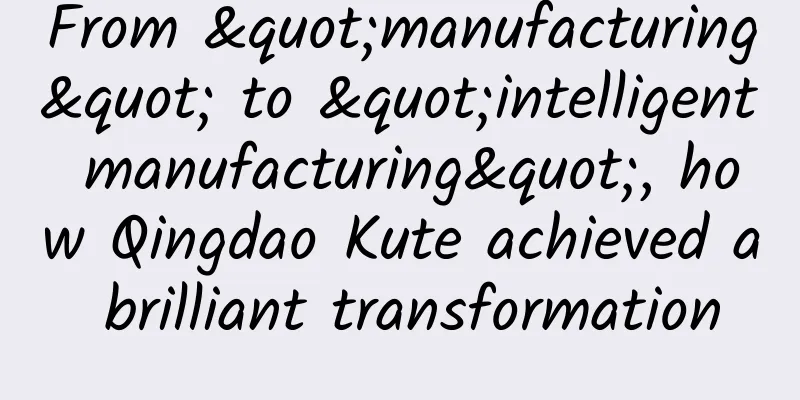From "manufacturing" to "intelligent manufacturing", how Qingdao Kute achieved a brilliant transformation

|
[51CTO.com original article] Enterprise digital transformation is an inevitable innovation for the future. In the era of Industry 4.0, "intelligent manufacturing" will replace "manufacturing" in the near future. However, the transformation from "manufacturing" to "intelligent manufacturing" is not smooth sailing. How can traditional enterprises overcome difficulties and successfully achieve transformation and upgrading? In the process of promoting transformation, with the expansion of enterprise business and the complexity of data processes and business applications, how can the network play its key role? As a model of manufacturing industry facing the Industrial 4.0 era, the digital transformation of Qingdao Cooter Intelligent Co., Ltd. (hereinafter referred to as Cooter) is a "model" in the industry. How did Cooter break through the network bottleneck and achieve a gorgeous transformation from "manufacturing" to "intelligent manufacturing"? With this question, 51CTO recently interviewed Li Kepeng, vice president of Cooter Yunlan Institute of Technology, and Shao Deqiang, deputy general manager of Ruijie Networks' large and medium-sized enterprise system department.
Shao Deqiang (left), deputy general manager of Ruijie Networks' large and medium-sized enterprise system department, and Li Kepeng (right), deputy dean of Coote Yunlan Institute of Technology Cross the river by feeling the stones, trial and error step by step Kute has more than 3,000 employees and currently has three professional manufacturing factories, mainly suit factories, shirt factories and casual pants factories. Its product categories cover men's and women's clothing, and it mainly provides people with intimate fashion consultants and personalized customization services. Since 2003, Coote has used its own factory as a laboratory to focus on the research and practice of "Internet + Industry", forming the Coote Intelligent Model with "large-scale personalized customization" as the core, summarizing a set of thorough solutions for the transformation and upgrading of traditional enterprises - data engineering, and creatively proposed a C2M business ecosystem in which consumers directly connect with factories in the "personalized customization" model. Coote's intelligent practice has subverted the traditional business genes, business genes, management genes, and manufacturing genes, forming the "Coote Cloud Blue Governance Way". According to Li Kepeng, as one of the earliest traditional enterprises to move towards informatization, Kute had no model to learn from and could only rely on its own exploration and trial and error. "Initially, our goal was to provide personalized customization, but we had to use industrialized means to achieve it. Our informatization construction is like a patient, we treat the pain wherever it occurs." Li Kepeng pointed out that in the digital transformation and upgrading, "the network is a very important link in the production of smart factories." Because the entire process of the Cooltech factory, from customer demand to order generation in the order system, to R&D, raw materials, materials, production and manufacturing, to final delivery, is inseparable from the network. "In addition, network security is very core to the enterprise. Once attacked, the entire factory will also be shut down." All of Kute's products are customized, and each product is different. There are various process data and order forms behind them. How to accurately provide these data to each employee is very critical. After the information upgrade, Kute's factory has nearly 2,000 intelligent devices, whether it is intelligent logistics equipment, cutting equipment, or smart terminals on traditional sewing machines, all need to use wireless network signals. The quality of wireless network signals directly affects the production situation of the factory. As a data-driven smart factory, all information comes from data, and all instructions for Kute employees to operate also come from smart terminals. Suppose the standard process of making a suit jacket is 308 steps. If a process is delayed by 1 second, the completion of the jacket will be delayed by 308 seconds. If 4,000 pieces of clothing are made in a day, then the delay in a day will be 1,232,000 seconds! "Therefore, we have very high requirements for the stability and security of the entire network environment, and the timeliness and accuracy of the data generated," said Li Keping. In this regard, Shao Deqiang also said that in the process of transformation from "manufacturing" to "intelligent manufacturing", enterprises represented by Coote will inevitably have more and more smart terminals added to the production line and transmit data through wireless networks. Therefore, the network is very important for these enterprises, and they need wireless networks to achieve the following three points: First, high density. There are many terminals on the production line that need to be connected to the network. It is necessary to ensure that high-density terminals can access the network and carry data stably; Second, low latency and low jitter. Because all production data must be transmitted from the back-end sales system to the front-end as soon as possible, these production instructions are very real-time. Therefore, low latency is required; Third, high reliability. It is necessary to ensure that the wireless network can stably support production operations, because once a wireless network interruption occurs, it may cause a production line or a link to stop production, causing serious losses. Fourth, high security. We must strictly control the access rights of the production network wireless network to prevent accidents such as virus attacks or leaks of production business due to illegal terminals entering the network, which would cause significant losses in production and operation. How does Coote overcome challenges? In order to avoid losses caused by poor network, "In the beginning, we were just groping in the dark. We thought that big international brands would definitely be relatively better, although the prices were also high. But we still tried to use them. However, after using the equipment, disconnections occurred frequently, requiring our IT staff to go on site to restart it, which wasted time." Li Keping said. After this experience, the IT department began to reorganize its thinking and look for suitable suppliers, abandoning the idea of purchasing international brands. Products from various brands were selected for testing in the workshop, based on Coote's own needs, and through comparisons of cost-effectiveness and other aspects. Finally, Ruijie's smart factory solution was selected. Li Kepeng believes: "From a technical perspective, domestic products are not inferior to foreign brands in terms of technology, quantity or performance, and are even better in some areas. In addition, domestic network products are more developed based on the needs of Chinese companies, while international brands are mainly involved in large industries based on state-owned monopolies. The best ones are the ones that suit you, so I finally chose domestic brands." According to Shao Deqiang, first of all, in the Coote factory, Ruijie uses high-density tri-band APs. A single AP can carry twice as many terminals as traditional wireless APs, and can now support at least 150 terminals that can access concurrently. Secondly, many new technologies have been introduced to reduce data loss and wireless signal interference. In particular, the Pre-ax technology has been introduced to minimize wireless interference between terminals. Thirdly, in terms of high reliability, in order to ensure that the wireless coverage of the entire product line can be complementary, if any of the APs goes down due to uncontrollable factors, the surrounding APs will automatically expand the coverage area to make up for the loopholes and risks that may be caused by AP failures. This will improve the reliability of the entire system. It is reported that Ruijie's smart factory solution specifically uses "AP virtualization" technology to support two independent networks by deploying a set of physical APs. A single AP is virtualized into two virtual sub-APs, which are managed by two ACs for production and office respectively. The two ACs control their respective virtual sub-APs to send out different SSIDs, forming a dual-controller network isolated by tunnels, so that production and office can achieve high reliability without interfering with each other. At the same time, this technical solution also avoids the double cost and signal interference problems caused by the simultaneous deployment of two sets of physical APs. "Ruijie's smart factory solution involves wired, wireless, IT operation and maintenance, and security management and control, and has now been applied to multiple fields such as automotive manufacturing, food, and medicine." Based on Ruijie's smart factory solution, Coote has deepened and implemented the "source point" concept centered on customer needs, allowing this traditional garment production line to truly transform into a smart factory with large-scale customized production capabilities, and formed the industry-renowned "Coote Cloud Blue Model". From "manufacturing" to "intelligent manufacturing", Kute's successful experience tells us these As a benchmark enterprise in intelligent manufacturing, what successful experiences does Coote have to share with you? Li Kepeng believes that traditional enterprises need a complete set of solutions for transformation and upgrading. He suggests: First of all, enterprises need to find the right path and method for transformation and upgrading. Before finding the right path and method, enterprises should not invest blindly, but find the right tools first. If funds are limited, they can choose SaaS products to reduce their own development and maintenance expenses. Secondly, the road to transformation and upgrading is always on the way. What is important is that during the transformation process, enterprises must form their own core competitiveness and have the ability to maintain sustainable and healthy profitability in order to support the continuous iteration, upgrading and evolution of enterprises. Finally, transformation and upgrading must be supported by organizations and processes, because only through organizational change and process reengineering can the implementation of the enterprise path be supported. "In addition, enterprises do not need to invest too much at the beginning when transforming and upgrading to smart manufacturing. The most important thing is to activate existing resources, eliminate waste, improve efficiency and reduce inventory. In other words, it is to save resources and energy," Li Kepeng emphasized. Shao Deqiang also agreed with President Li's views. He said that every enterprise has its own development and transformation goals, and different business scenarios also correspond to different business support needs. For digital transformation enterprises, the following three points must be achieved: First, the "top leader" of the enterprise must support it. Second, the best is the most suitable. It must be combined with its own actual situation and cannot be copied. Third, it must be customized based on the actual business. Choose an overall solution that suits your business scenario, and choose a supplier who is willing to customize and provide you with differentiated solutions. These three points are relatively important. Finally, when talking about what innovations Ruijie will have in the field of intelligent manufacturing in the future as a network solution provider, Shao Deqiang said that in addition to conventional network communication guarantees and network applications, Ruijie is also trying to do predictive operation and maintenance through data collection and analysis, so as to provide guarantee for production application support. For example, in the past, the wear of lathe tools needed to be judged manually on site, because the quality of the tools directly affects the factory's yield rate. In the future, through data collection and analysis, it can be determined what the current speed is and whether the tool needs to be replaced. In summary, driven by Industry 4.0 and smart manufacturing, every link in the construction and operation of enterprise campus networks is extremely important to enterprises, especially the campus construction of large enterprises represented by Coote, which needs to meet the requirements of high performance and high reliability. In the construction of smart campus networks, not only the continuous exploration and innovation of enterprises themselves are needed, but also the support of third parties such as Ruijie. In short, creating distinctive Chinese smart manufacturing requires the joint efforts of enterprises and service providers. We believe that with the joint efforts of both parties, China's smart manufacturing will develop faster and better, and win a new future together! [51CTO original article, please indicate the original author and source as 51CTO.com when reprinting on partner sites] |
>>: With 5G commercialization imminent, what new moves will the three major operators make?
Recommend
It's over! Something big has happened to TCP!
= [[335538]] This article is reprinted from the W...
Will 5G really kill Wi-Fi? NR-U is here
5G is like an elephant running wildly in the wire...
Quick Start with Linkerd v2 Service Mesh
In this guide, we'll walk you through how to ...
SiberDC: $1.3/month Türkiye VPS - dual core/1GB RAM/30G SSD/1Gbps unlimited traffic
SiberDC is a foreign merchant founded in 2011, he...
BuyVM: Las Vegas 1Gbps unlimited traffic VPS bulk replenishment starting at 3.5 CAD/month, storage (disk space) can be purchased
BuyVM's Las Vegas data center VPS and storage...
What is a DDOS attack?
introduce DDoS is the abbreviation of Distributed...
Empowering the ecosystem and working together! Borei Data becomes a member of the Photosynthetic Organization
As the domestically-developed industry ecosystem ...
Virtono opens new San Jose data center: KVM annual payment starts at 11.21 euros, 40% off for monthly payment
I received an email from Virtono, in which the me...
GreenCloudVPS Kansas node is online, 2G memory package starts at $15 per year
GreenCloudVPS has launched its 30th data center p...
Key Roles of Artificial Intelligence in Mobile App Development
[[431728]] 【51CTO.com Quick Translation】 Today, t...
SpeedyPage 10% off, starting from $4.83/month-AMD Ryzen, DDR5 memory, Gen4 NVMe, Ashburn computer room
SpeedyPage recently launched a high-performance V...
CheapWindowsVPS 20% off for the first month, 4G memory 1Gbps unlimited traffic KVM 7.2 USD for the first month, 8 computer rooms available
At Cheap Windows VPS, we are always innovating ou...
Gossip about the upcoming 5G era: the three-player pattern
5G is coming soon, and now is the eve of it. Let&...
Empowering IDC infrastructure, can 5G achieve data transmission at the speed of light?
The fifth generation of cellular networks is gett...
How fast is 5G? Is the radiation strong? Does it have any effect on the human body? Here comes the authoritative interpretation!
What are the improvements of 5G network compared ...








![[Black Friday] HawkHost virtual hosts up to 35% off, reseller hosts/cloud servers up to 30% off](/upload/images/67cac23f66265.webp)
